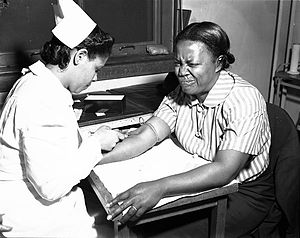疼痛
| 疼痛 | |
|---|---|
 | |
| 一位婦女在抽血時的痛苦表情 | |
| 類型 | 症狀、不愉快性[*]、痛苦、知覺、sensation perception[*] |
| 分類和外部資源 | |
| 醫學專科 | 神經內科 |
| ICD-10 | R52.9 |
| DiseasesDB | 9503 |
| MedlinePlus | 002164 |
身體的疼痛(pain)是由疾病、創傷、外在傷害性刺激,伴隨現有的或潛在的組織損傷,所引起在知覺上或情緒上難受的、不愉快的感覺。疼痛是主觀性的,影響的範圍可為身體局部或整體,屬一種複雜的生理、心理活動。
出於臨床研究的需要,國際疼痛研究國際疼痛研究協會將疼痛定義為「由真正存在或潛在的身體組織損傷所引起的不舒服知覺和心理感覺」。[1][2]
疼痛是主觀的感覺,早於1968年疼痛處理專家馬戈·麥加費利首次提出一個在護理學界普遍使用的定義:「一個人說感到痛,這就是痛;他說痛仍在,痛就仍在。」(原文:Pain is whatever the experiencing person says it is, existing whenever he says it does.)[3][4]
身體疼痛是看醫生的主要原因;在美國,有一半看醫生的人是因為疼痛,是最普遍的原因。[5]疼痛也是大部分病患的徵狀,可根據維持時間、強度、種類(如火燒、針刺感等)、位置等來診斷。通常疼痛會自然消退,或通過簡單的止痛處理後消退,這可稱作「急性」疼痛。但有時疼痛本身已是一種病患,如慢性疼痛。近年痛症引起了不同學科專家的關注,如藥理學、神經生物學、護理學、物理治療和心理學,並形成了疼痛管理這門在麻醉學、物理治療、神經學、精神科等專科之下的附屬專科[6]。
人體的痛覺神經有六種[需明示出處],但科學上紀錄有人無法感受痛楚,這種病是先天性無痛症,英文簡稱為「CIP」。
用語區分
[編輯]漢語中,痛與疼是近義詞;在語意上,痛的含義較廣泛,痛包含疼,且痛大於疼。「痛」較偏向慢性的、長久持續的、深入的、鈍挫的疼痛。「疼」則較偏向急性的、短暫間斷的、淺表的、熱灼的、開放發散的、尖銳的疼痛[7]。
身體的「疼痛」,是主觀、有意識的感覺。而「痛覺」,則指感受器、周圍神經系統、脊髓和腦受有害刺激而引起的無意識活動[8]。一般而言,痠、痛、乏的症狀與肌肉、軟組織損傷較有關,而麻、抽、脹的感受則多和神經病變較相關;神經痛及神經性疼痛則為例外情形。
分類
[編輯]痛覺感受器受到化學、熱力或撞擊等可損傷身體組織的刺激就可能會產生疼痛。若神經系統由病患或損傷而受損,可引致神經痛症或神經性病變痛症[9]。由感受器受刺激和神經系統受損引起的疼痛是兩大主要疼痛發生機制,第三類是精神性疼痛,較為罕見。
其中,痛覺感受器引起的疼痛可細分為三種:[10]
- 表面軀體疼痛(或皮膚疼痛)由皮膚或身體表面組織受損而引起。由於皮膚痛覺感受器分布細密,所以其產生的痛覺明顯、位置明確但短暫。小傷口和輕度燒傷引起的疼痛屬此類。
- 深層軀體疼痛源自韌帶、腱、骨、血管或肌肉,由軀體痛覺感受器感應,其分布較疏,引起隱隱作痛的感覺,位置亦不明顯。扭傷、斷骨和肌膜疼痛症候群屬此類。
- 內臟疼痛源自身體的器官。內臟痛覺感受器的分布更疏,產生的痛感更不易定位,且可轉化為體腔壁痛、牽涉痛。
疼痛與疾病
[編輯]疼痛是許多疾病的常見或主要症狀,如腦腫瘤的頭痛、冠心病發作時的胸痛,膽石症的膽絞痛和腹痛、晚期癌症患者的癌性疼痛等。有些疼痛本身就是一種疾病,如帶狀皰疹的神經痛、三叉神經痛。疼痛不僅給患者帶來痛苦,而且還對人體中樞神經、循環、呼吸、內分泌、消化和自主神經等系統造成不良影響,甚至是某些嚴重的、威脅生命的疾病症狀。[11]
參見
[編輯]註釋和參考
[編輯]- ^ This often quoted definition was first published in 1979 by IASP in Pain journal, number 6, page 250. It is derived from a definition of pain given earlier by Harold Merskey: "An unpleasant experience that we primarily associate with tissue damage or describe in terms of tissue damage or both." Merskey, H. (1964), An Investigation of Pain in Psychological Illness, DM Thesis, Oxford.
- ^ See IASP Pain Terminology 網際網路檔案館的存檔,存檔日期2008-05-12.. The whole entry on the term pain itself reads like this:
Pain. An unpleasant sensory and emotional experience associated with actual or potential tissue damage, or described in terms of such damage. Note: The inability to communicate verbally does not negate the possibility that an individual is experiencing pain and is in need of appropriate pain-relieving treatment. Pain is always subjective. Each individual learns the application of the word through experiences related to injury in early life. Biologists recognize that those stimuli which cause pain are liable to damage tissue. Accordingly, pain is that experience we associate with actual or potential tissue damage. It is unquestionably a sensation in a part or parts of the body, but it is also always unpleasant and therefore also an emotional experience. Experiences which resemble pain but are not unpleasant, e.g., pricking, should not be called pain. Unpleasant abnormal experiences (dysesthesias) may also be pain but are not necessarily so because, subjectively, they may not have the usual sensory qualities of pain. Many people report pain in the absence of tissue damage or any likely pathophysiological cause; usually this happens for psychological reasons. There is usually no way to distinguish their experience from that due to tissue damage if we take the subjective report. If they regard their experience as pain and if they report it in the same ways as pain caused by tissue damage, it should be accepted as pain. This definition avoids tying pain to the stimulus. Activity induced in the nociceptor and nociceptive pathways by a noxious stimulus is not pain, which is always a psychological state, even though we may well appreciate that pain most often has a proximate physical cause.
- ^ McCaffery M. Nursing practice theories related to cognition, bodily pain, and man-environment interactions. LosAngeles: UCLA Students Store. 1968.
- ^ More recently, McCaffery defined pain as "whatever the experiencing person says it is, existing whenever the experiencing person says it does.」 Pasero, Chris; McCaffery, Margo. Pain: clinical manual. St. Louis: Mosby. 1999. ISBN 0-8151-5609-X..
- ^ National Pain Education Council 網際網路檔案館的存檔,存檔日期2008-06-13.
- ^ From the American Board of Medical Specialties 網際網路檔案館的存檔,存檔日期2008-05-16. website: "Pain Medicine is the medical discipline concerned with the diagnosis and treatment of the entire range of painful disorders. (...) Due to the vast scope of the field, Pain Medicine is a multidisciplinary subspecialty (...)."
- ^ 徐文兵. 字里藏医. 安徽教育出版社. 2007: 93. ISBN 9787533647582.
- ^ "Activity induced in the nociceptor and nociceptive pathways by a noxious stimulus is not pain, which is always a psychological state, even though we may well appreciate that pain most often has a proximate physical cause." Source: IASP Pain Terminology 網際網路檔案館的存檔,存檔日期2008-05-12..
- ^ Compare definitions at IASP Pain Terminology 網際網路檔案館的存檔,存檔日期2008-05-12.: "Neurophathic pain — Pain initiated or caused by a primary lesion or dysfunction in the nervous system." and "Neurogenic pain — Pain initiated or caused by a primary lesion, dysfunction, or transitory perturbation in the peripheral or central nervous system."
- ^ Pain Physiology 網際網路檔案館的存檔,存檔日期2008-04-01.
- ^ 王惠霞. 麻醉与疼痛. 世界圖書出版廣東有限公司. : 2. ISBN 978-7-5100-4566-0 (中文).
